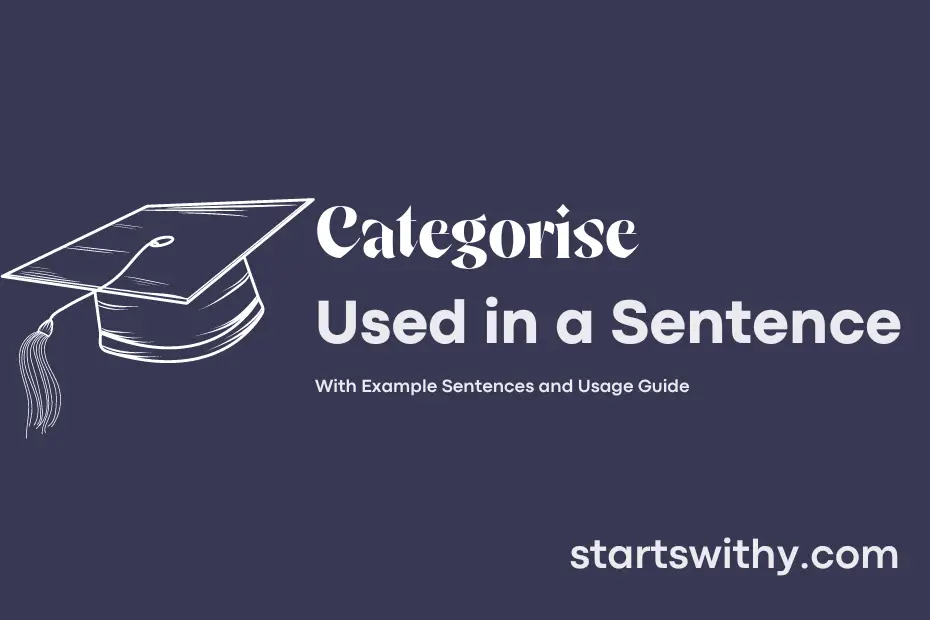Have you ever wondered how we can organize information effectively? Categorising is the process of grouping items based on shared characteristics or criteria. This method helps to create order and make sense of complex data.
When we categorise information, we can easily access and retrieve specific details. By sorting items into distinct groups, we simplify our understanding and enhance our ability to identify patterns or similarities. This systematic approach is widely used in various fields such as science, literature, and education.
7 Examples Of Categorise Used In a Sentence For Kids
- We can categorise fruits based on their colors.
- Let’s categorise animals as wild or domestic.
- We will categorise shapes by their number of sides.
- It’s fun to categorise toys by their sizes.
- Let’s try to categorise things by their shapes.
- We can categorise books by their genres.
- Let’s categorise our toys into different groups.
14 Sentences with Categorise Examples
- Categorise your study materials based on subjects to keep them organized.
- Before starting a new semester, it’s helpful to categorise your notes from the previous semester.
- It’s important to categorise potential research topics to make it easier to choose one for your project.
- Categorise your expenses to track where your money is going each month.
- When creating your study schedule, don’t forget to categorise tasks based on priority.
- Categorise your assignments based on deadlines to prioritize your workload.
- To make your job search easier, categorise potential companies based on your preferences.
- Before starting a group project, it’s a good idea to categorise each member’s strengths and assign roles accordingly.
- When studying for exams, it can be helpful to categorise your notes by topic to focus on one subject at a time.
- Categorise your reading list based on genres to easily choose what to read next.
- As you prepare for your internship interviews, categorise your skills and experiences to highlight the most relevant ones.
- Categorise your goals into short-term and long-term categories to track your progress effectively.
- When planning your extracurricular activities, categorise them based on your interests and availability.
- To improve your time management, categorise your daily tasks into urgent, important, and non-urgent categories.
How To Use Categorise in Sentences?
To use Categorise in a sentence, first, identify the specific object or idea that you want to classify into different groups or categories. Next, think about the characteristics or attributes that define these categories. For example, if you want to categorise different types of animals, you might consider their habitats, diets, or physical characteristics.
Once you have identified the object and its categories, you can use the word Categorise in your sentence. Start by introducing the object or idea you are categorising, followed by the specific categories you are assigning it to. For instance, “I need to categorise these books based on their genres into fiction, non-fiction, and self-help.”
Remember to use Categorise as a verb in your sentence to indicate the action of classifying or grouping objects or ideas. It is essential to ensure that your sentence clearly communicates the relationship between the object and its categories to effectively use the word Categorise.
Practice using Categorise in various sentences to become more comfortable with its usage and to enhance your communication skills. Over time, you will become more adept at categorising different things accurately and efficiently.
Conclusion
In conclusion, the act of categorising is a fundamental process of organizing information into distinct groups based on their shared characteristics or properties. By categorising, we are able to make sense of complex data, identify patterns, and draw meaningful conclusions. For example, in scientific research, data is often categorised into different groups to facilitate analysis and interpretation.
Categorising can also aid in decision-making, problem-solving, and efficient communication by simplifying complex information into manageable chunks. This process is evident in everyday life, from organising files on a computer to sorting items in a grocery store. In essence, categorising serves as a practical tool that helps us make sense of the world around us and navigate the wealth of information available in a structured and meaningful way.



